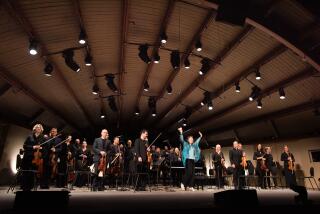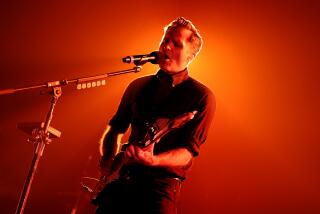Japan a bit dizzy over U2’s ‘Vertigo’ tour
- Share via
TOKYO — It had been eight years between U2 gigs in Japan, so perhaps it shouldn’t have been surprising that the restrained Tokyo audiences the quartet remembers from previous tours have since morphed into a dancing, bouncing, singalong, air-punching mob.
Then again, who in the world is going to sit through “Vertigo”?
But from the opening guitar riff and cascading piano chords of “City of Blinding Lights” that kicked off these shows, the crowds in this city with the most blinding lights anywhere showed a rarely exhibited exuberance and joy. They embraced a band that until this week had wondered whether it had ever cracked Japan the way it owns the rest of the planet.
The Tokyo crowd’s extroversion came more easily, of course, because the four Irish musicians played with their own exuberance and joy while wrapping up one of the most successful rock tours ever mounted.
The odyssey began 19 months ago in San Diego (after a press preview in L.A.) and will end more than 100 shows later -- with a final gig in Honolulu on Saturday. Salting set lists with material from 2004’s “How to Dismantle an Atomic Bomb,” the latest studio album, and “Boy,” their first, released 26 years ago, the band wound down this tour extended by having to cancel 10 shows last March due to an illness in the family of an undisclosed band member.
The “Vertigo” tour has incorporated the rock concert innovations of the last few years: video screens that deliver intimacy to the back of the hall; the wall of lights that can take you via video to Africa in the middle of “Where the Streets Have No Name”; the political sloganeering superimposed over a rumbling rhythm section.
The three Tokyo-area shows had an even greater in-your-face feeling because the band actually squeezed its outdoor staging into the 20,000-capacity Saitama Super Arena. U2 arrived in Japan having played nine outdoor shows in the Australian and New Zealand spring, traveling with two long ramps that end in pods, extended like antennae from the main stage deep into the audience.
It was from these “B” stages that Bono showcased the three maikos -- apprentice geishas -- whom he had met in Kyoto on the weekend and who ghosted across the set during “Mysterious Ways.” The walkways allowed Bono and the Edge to ramble through the audience, making it even harder for the Japanese audience to resist the summons to dance.
It is less certain if Bono’s political messages had the same penetration with the crowd. The singer has used this tour, as always, to proselytize for African debt relief and trade justice, spending part of his time over eight days in Japan on a media blitz to raise awareness of the “Hottokenai,” Japan’s chapter of the “Make Poverty History/One” campaigns.
Japan is the world’s second largest aid donor, and Bono chose flattery rather than confrontation during a short meeting with Prime Minister Shinzo Abe, praising the country’s international development record. But Japan’s nongovernmental organizations must operate in a culture beset by widespread political apathy and little tradition of individual activism.
The “Vertigo” tour has made a point of trying to inspire them. While the set lists frequently switched songs through the first hour, the block before the first encore was solidly political content, running from “Sunday Bloody Sunday” through “Bullet the Blue Sky” and culminating with the anthem “One.” The band used this part of the show to scroll the Universal Declaration of Human Rights, in Japanese, on the wall behind them.
The temperature in the arena rose little through the message moments. Japan was one of the only stops on the tour outside Europe and the Americas, which may account for some of the usual tricks falling flatter than expected. Bono opened the show waving a Japanese flag, a move that might pull roars in Australia but that sends mixed signals in a country currently watching conservative politicians pass a law compelling students to face the flag and sing the national anthem every morning.
Similarly, “Sunday Bloody Sunday” has gone from its roots in the Irish Troubles to a prayer for peace in a time of Middle East bloodshed. But although Japan has a small contingent of troops in Iraq to show solidarity with its U.S. ally, the Buddhist country is mostly an observer in the combustible collision between Christians, Muslims and Jews. The antiwar chants of “No more!” lacked the passion you’d hear from a Western crowd.
Nor, for all its excitement, could the crowd muster much of a singing voice when Bono offered it the mike. From Dublin to Sao Paulo, crowds roar their lines back at the band.
But here, that instinctive Japanese reserve appeared to kick in. After one lame effort, Bono sucked his thumb and laughed at them.
Yet the pleasure of a U2 gig often lies in small, unexpected moments: the Edge’s subtle altering of a well-known riff, a cover or a new song (U2 played the first live version of its upcoming single “Window in the Skies” in Tokyo) or Bono’s signature drift from a U2 song into a snippet from the rock archives.
In Tokyo, the singer came out of “Beautiful Day” for a moment to sing a verse of “Presence of the Lord” from Blind Faith, Eric Clapton’s band after Cream disbanded. Clapton was in the crowd (he has his own set of concerts here this month), standing stoically at the back of the hall near the mixing board, and didn’t recognize the tune at first.
Then, suddenly, he did, jumping forward to tap a colleague on the shoulder.
“That’s my song,” Clapton said, gesturing at the stage.
“When was the last time you played that song?” he was asked.
“I haven’t even heard it for 20 years,” he said. “But it’s a great idea!” Ah. Tired of U2?
Tired of life.
More to Read
The biggest entertainment stories
Get our big stories about Hollywood, film, television, music, arts, culture and more right in your inbox as soon as they publish.
You may occasionally receive promotional content from the Los Angeles Times.










